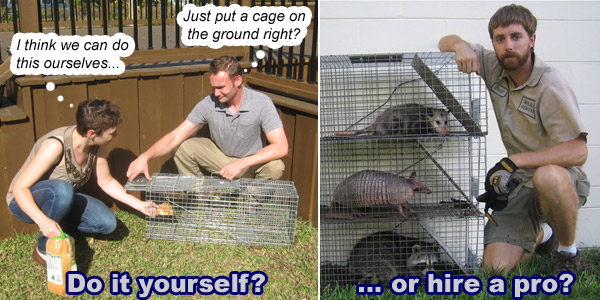How to trap a raccoon -
Almost all people are aware or are familiar with the name raccoon especially if you are living in North America. Common raccoons have been said to be originally found in forests and marshes but because of several factors like massive deforestation which might have destroyed the habitats of these mammals they are able to find their way into the cities. They are quite adaptable so they have been living with some of the stray animals in sewers or have become pests in our households.
Type of Trap: A large, sturdy cage trap with a trip pan. At least 32 inches long, and 12x10 tall and wide. Many manufacturers make raccoon-sized traps, including HavaHart and Tomahawk brand.
What Kind of Bait? These omnivores will eat almost anything. Some trappers like sardines, some like white bread, I like marshmallows the best.
Placement, Location: This is very key. Don't set the trap any place the animal can reach out and destroy anything. Set it in the shade, so the trapped animal doesn't bake in the sun.

The truth is that trapping is not easy, at all. I've done it for years, and in my first year, my first 100 or so raccoon jobs, I made many mistakes. Also, I am a state licensed professional. In almost all states, it is not legal
for homeowners to trap and relocate raccoons. It may seem simple, like in the above picture, but so many things can go wrong, and almost all attempts I see by homeowners are laughable at best, but harmful to animals and property at worst. Please,
at least consider calling a licensed professional in your area before you attempt to do it yourself. It could be a mother raccoon with babies, it could be rabid, there are so many variables. I recommend that you talk to a professional raccoon
control expert in your town by clicking on my
National Wildlife Control
directory, which lists experts who I recommend in every USA city and town who can
help you with your raccoon issue.
Still, I will continue with some raccoon trapping tips and hints below, in case you are stubborn.
These animals are nocturnal, so they pretty much go out at night to catch their prey or find food. They are omnivores so they can basically eat meat, fish, vegetables, fruits and all possible food items that people store in their cupboards. They are medium sized normally gray in color and with a somewhat bushy tail. They have sharp claws which can easily tear many plastic containers and even break tiny branches or twigs of trees which they feel might be edible.
Because they have become a constant headache to many people who don’t like pests around their homes, stealing food and causing mayhems in the attic; it has become the custom of many individuals to try to catch a raccoon and bring it somewhere far so they won’t be able to cause any more trouble. The only problem is raccoons are said to be intelligent that they are able to find their way back so sometimes people tend to just kill them which is not advisable as some States would have laws which makes it illegal to kill a raccoon or any animal for that matter.
If you find that having a raccoon in your home is a nuisance then here are some tips that may help you.
1. You should be aware of the existing laws in your state about capturing or trapping a raccoon. Some states don’t usually allow just anybody to trap or capture them without a proper license so you have to call an authorized agency to get rid of the unwanted boarder in your homes. You should also be aware if your local ordinances would allow you to release the raccoon after trapping it and if so where would be the preferred areas to release them. If it is not allowed then you don’t have any choice than probably to humanely kill it if it is allowed otherwise you seek the help of the nearest wildlife agency to take care of it for you.
2. The next thing to do is set up a trap. If you already saw the size of the raccoon rummaging inside your house or probably living in your attic, try to buy a trap large enough to contain it but without suffocating it. If it happens that there are baby raccoons in the attic, don’t trap the mother first without getting the babies. If you leave the babies behind, they might just die of starvation and stink in your attic. If you feel you might need bait the best thing that could entice them is a dry cat food with a mixture of some seafood in it.
3. If the animal is not lurking inside the house but is causing too much problem like scattered, smelly garbage from your trashcans every morning; try to eradicate the thing that attracts them by securing the garbage with bungee cords.
4. Normally raccoons scavenge at night so try to check your trap very early the next day. You have to make certain that it’s a raccoon that you caught and not a cat especially because you have used cat food to lure the animal in which might also put your neighbors’ cats in immediate danger. It might even bring in stray cats which are very dangerous.
5. If you have successfully captured it inside the cage, be very careful and try to give enough space between yourself and the cage because it might reach out and scratch you to bleed.
6. You have to release the animals ten miles away from the place where you caught them because chances are they might be able to find their way back and you would still have the same problems as before.
Go back to the
How To Get Rid of Raccoons home page.